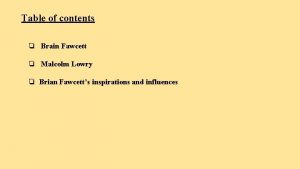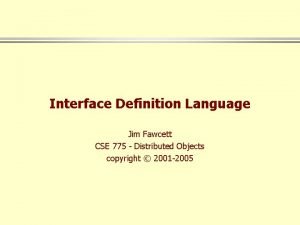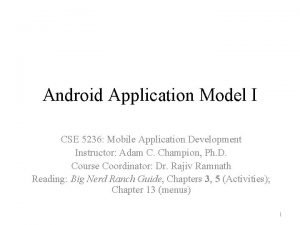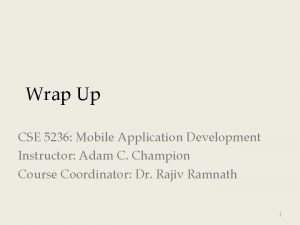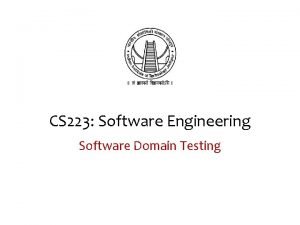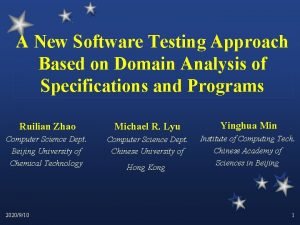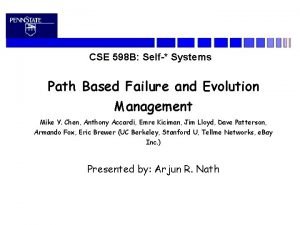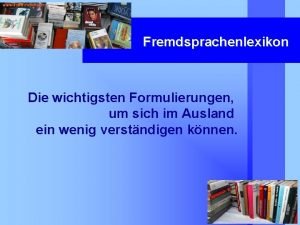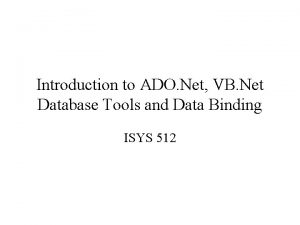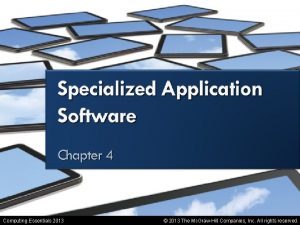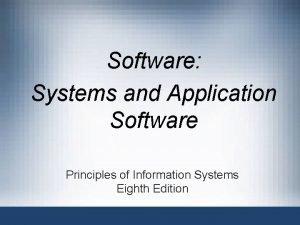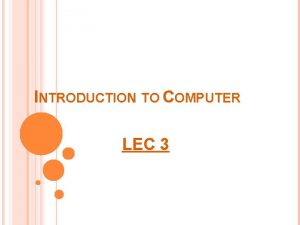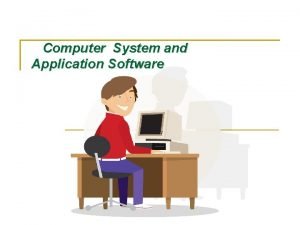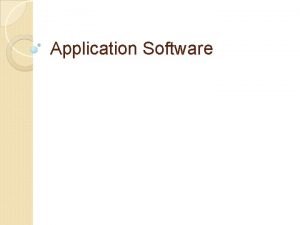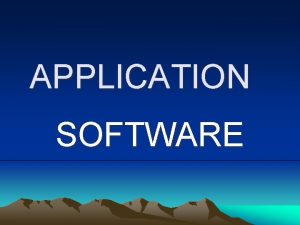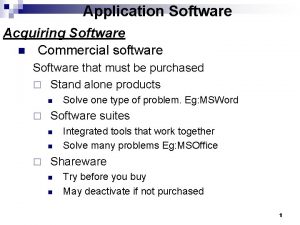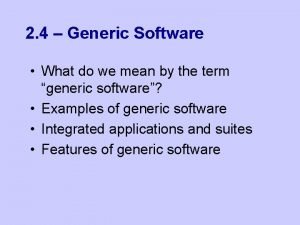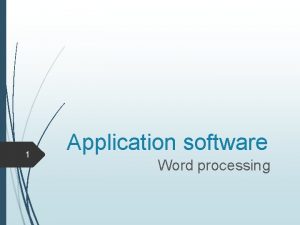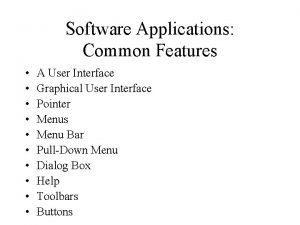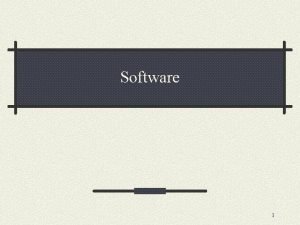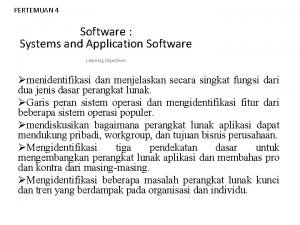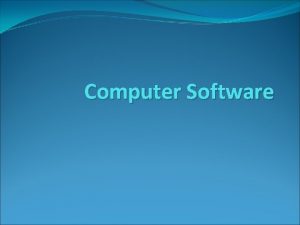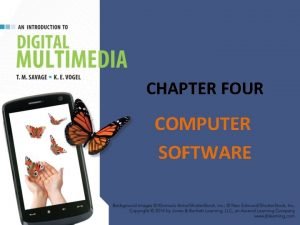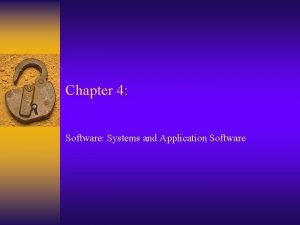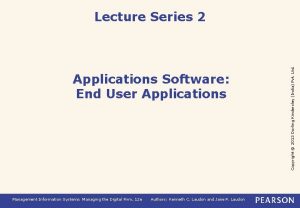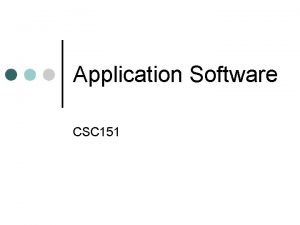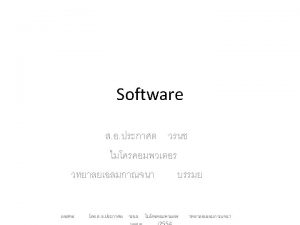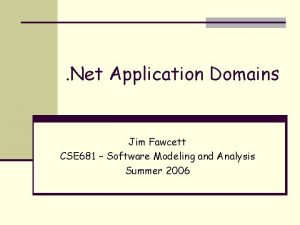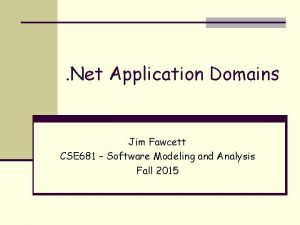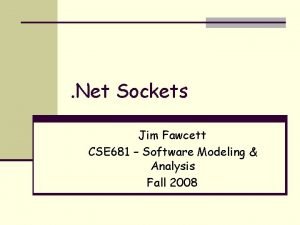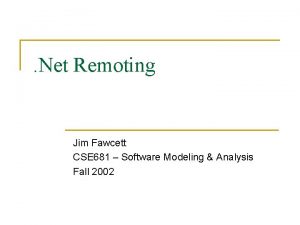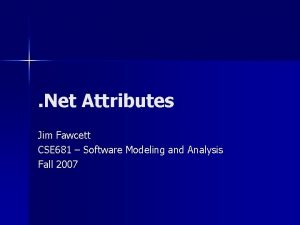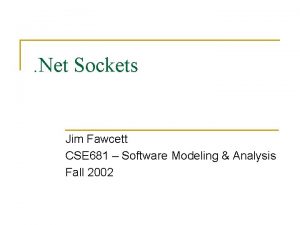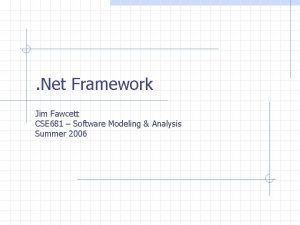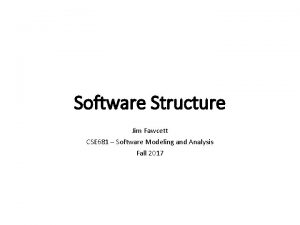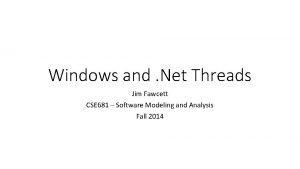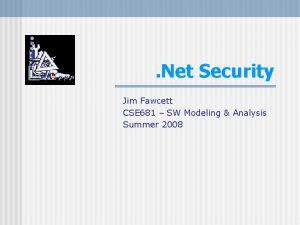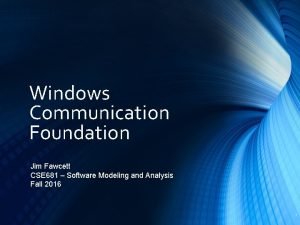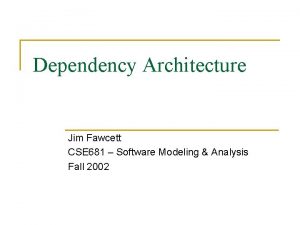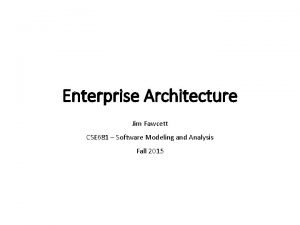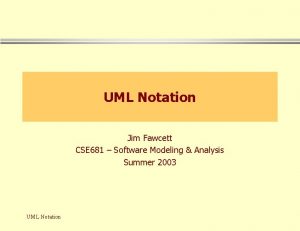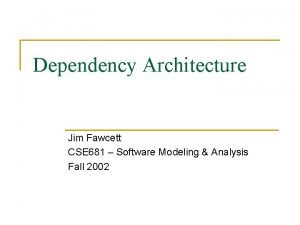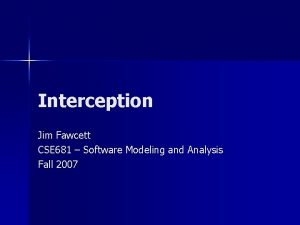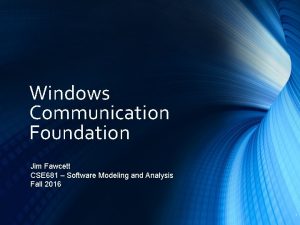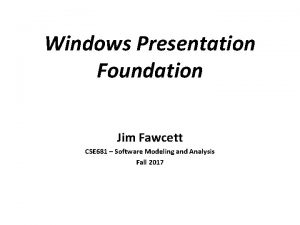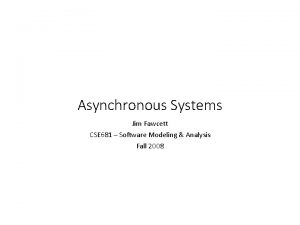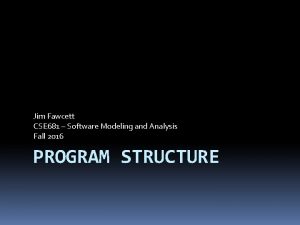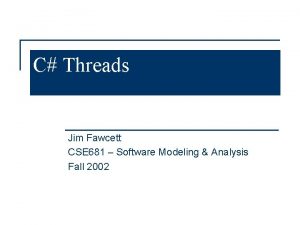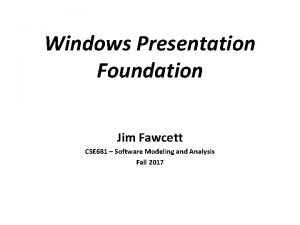Net Application Domains Jim Fawcett CSE 681 Software













































- Slides: 45

. Net Application Domains Jim Fawcett CSE 681 – Software Modeling and Analysis Summer 2006

Agenda n Role of App. Domains n Application isolation n Visibility n Data n Security settings n Type safety and verification n Dynamic application extensions n App. Domain structure n App. Domain managers n Summary Using App. Domains Effectively 2

References n Common Language Runtime, Steven Pratschner, Microsoft Press, 2005 n Essential. Net, Volume 1, Don Box with Chris Sells, Addison-Wesley, 2003 n www. ecs. syr. edu/faculty/fawcett/handouts /CSE 681/code/Test. Harness. Prototype Using App. Domains Effectively 3

Role of Application Domains n Memory Access Isolation n Isolate unrelated applications from each other at run time. n n n Win 32 Processes CLR Appdomains Intent is to make system as stable as possible and minimize security exploits. n Web services and ASP applications run in App. Domains to isolate them from IIS Using App. Domains Effectively 4

What is an Application Domain? n An execution environment in which managed code runs n Safe managed code in an application domain is isolated from safe managed code running in any other. n Safe code is code that can be verified by the JIT compiler. n C# with no unsafe regions, is safe code. n Application domains are cheaper to start, unload, and run, than Windows processes, in terms of CPU cycles and memory. n It is cheaper to make calls between App. Domains that between Windows processes. Using App. Domains Effectively 5

What is a Module? n CLR programs reside in Modules contain: n Code(IL code) n Meta. Data ( module description) n Resources (any external resource) n Modules are not deployable components Using App. Domains Effectively 6

Assemblies continued n Modules are the physical structure of a program that resides in file system n Assembly is a logical construct that the CLR uses to access modules n Assemblies are deployable modules n n n Each assembly has a manifest Assemblies might have multiple modules Only one manifest exists per assembly n Manifests describe the modules in the assembly n Assembly can be: n Executable application n Library Using App. Domains Effectively 7

Assemblies Using App. Domains Effectively 8

Application Domains and Processes n Each application domain runs in the context of one and only one native Windows process. n A windows process can have no application domains, one, or many. Using App. Domains Effectively 9

Creating Child App. Domains n App. Domain. Setup d. Info = new App. Domain. Setup(); d. Info. Application. Name = ADname; Evidence evidence = App. Domain. Current. Domain. Evidence; n App. Domain child = App. Domain. Create. Domain( ADname, evidence, d. Info ); Using App. Domains Effectively 10

Loading Assemblies into App. Domain n If child is a child App. Domain, then: n child. Load(assembly); Probes paths beneath application and private paths to find an assembly to load, using Fusion rules, where assembly is the assembly name, without extension. n Load can be called by anyone with a reference to the App. Domain instance. n Assembly. Load. From(file. Spec); Loads specific assembly into current App. Domain, so to load into the child, this must be called from code in the child domain. n This is what the Test Harness prototype does. Using App. Domains Effectively 11

Unloading n The Win 32 API provides Load. Library and Unload. Library for injecting and removing libraries from an application dynamically. n The. Net CLR does support loading, but does not support dynamically unloading libraries. n You have to create a child domain, load libraries into it, and unload the domain when you are done, using: public static App. Domain. Unload(App. Domain); Using App. Domains Effectively 12

Communicating between App. Domains n Creating and using types in child domain: n Object. Handle oh = ad. Create. Instance(Assembly, a. Type); n a. Type p = oh. Unwrap() as a. Type; n Use p, a proxy, just like an instance of a. Type. This creates a proxy, typed by the CLR as a. Type. The proxy, p, marshals all calls to the real object in the child domain. Using App. Domains Effectively 13

Communicating between App. Domains n Access using App. Domain Dictionary n public virtual void App. Domain. Set. Data(string key, object value); marshals a reference into dictionary. n public virtual object App. Domain. Get. Data(string key); returns a proxy to object in other domain. n Dictionary objects must derive from Marshal. By. Ref. Object Using App. Domains Effectively 14

Isolation – Win 32 IIS Example n In IIS, Prior to. Net, you had the choices: n Load and run (ISAPI) application dlls in IIS process and possibly take down the server. n Run (CGI) application as a separate process, paying interprocess communication performance penalty. n Run (ASP) script with scripting performance penalty and development issues. n Use “standard” COM objects loaded inproc and accessed from script to improve performance, so just like ISAPI, but known quantities “may” be safe. Using App. Domains Effectively 15

Isolation -. Net IIS Example n In IIS, with. Net, you have all the previous choices plus: n Run applications (ASP. Net and Web Services) each in its own child App. Domain, loaded by IIS, but isolated from it. n n CLR isolates code loaded into child domain from the application running in primary App. Domain. This is the default processing model supported by both ASP. Net and Web Services. Using App. Domains Effectively 16

Objects and Types n An object resides in exactly one App. Domain, as do values. n Object references must refer to objects in the same App. Domain. n Like objects, types reside in exactly one App. Domain. So if two App. Domains need to use a type, one must initialize and allocate the type once per App. Domain Using App. Domains Effectively 17

Types cont. n If a type is used in more than one App. Domain, one must load and initialize the type’s module and assembly once for each App. Domain the type is used in. n Since each such App. Domaintains a separate copy of the type, each has its own private copy of the type’s static fields. Using App. Domains Effectively 18

Isolation – Visibility n Type visibility n When a type is loaded into a child App. Domain it is visible only within that domain unless it is also loaded or marshaled back into the primary domain. n An instance of a type can be marshaled by value, which results in a serialization, transmission, and deserialization. § Class must be attributed as [serializable()] n An instance of a type can also be marshaled by reference, which creates a proxy in the using domain. § Class must derive from Marshal. By. Ref. Object n Usually, we want to marshal by reference, because we want the instance to run in the child domain. Using App. Domains Effectively 19

Resources and Memory n An App. Domains’ resources are held in memory as long as the owning App. Domain is loaded. n Unloading an App. Domain is the only way to unload a module or an assembly or to reclaim the memory consumed by a type’s static fields. Using App. Domains Effectively 20

Test Harness Example n The test harness example, discussed in CSE 681 and CSE 784 illustrates this visibility: n n n The primary domain coerces a child domain to load a “loader” into a child domain and marshal back a reference to it. The primary domain then, using the loader reference, instructs it to load a collection of test assemblies for processing. The affects of this are: n The primary App. Domain only knows about the loader type, not all the testing types. n The test manager, running in the Primary App. Domain is isolated from failures of the test and tested code. Using App. Domains Effectively 21

Test Harness Configuration Using App. Domains Effectively 22

Isolation – Configuration Data n Each App. Domain in a process can be independently configured, either programmatically or with a configuration file. n Each application domain may have a configuration file that can be used to customize: n n Local search paths Versioning policy, e. g. , what is allowed to run Remoting information User defined settings Using App. Domains Effectively 23

App. Domain Config Files n An App. Domain config file resides in the process exe’s directory and has the process exe’s name with. config extension: n my. Process. exe. config n That can be changed with App. Domain. Setup. Configuration. File = new. Path; n Some examples: http: //blogs. msdn. com/suzcook/archive/2004/05/14/132022. aspx n Config file schema: http: //msdn. microsoft. com/library/default. asp? url=/library/enus/cpgenref/html/gngrf. NETFramework. Configuration. File. Schema. asp Using App. Domains Effectively 24

Isolation – Security Settings n Application domains can be used to modify Code Access Security (CAS) settings applied to code running within the domain. You can modify CAS policy for the domain. That maps code identity, based on evidence, to a set of granted permissions. n You can also set security evidence on the domain itself. If the grants for the domain are less than the grants for the assembly, the domain wins, and vice versa. n Using App. Domains Effectively 25

Isolation - Static Data n Static members of classes are isolated by App. Domains: If the same type is loaded into a parent and child domain, they are considered to be distinct types, and do not share static members. n If code is loaded domain-neutral, the code base is shared, but separate copies are maintained for all static members. n Using App. Domains Effectively 26

Process Resources not Isolated n Resources not isolated to an App. Domain: n Managed heap n Managed threads n CLR prevents data and behavior leaks Managed Thread. Pool n Mutexes and Events n n If named, these kernel objects are shared across App. Domains Using App. Domains Effectively 27

App. Domain Events n The App. Domain Type supports a handful of events that allow interested parties to be notified of significant conditions in a running program. n Events: n n n n Assembly. Load Assembly. Resolve Type. Resolve Resource. Resolve Domain. Unload Process. Exit Unhandled Exception Using App. Domains Effectively 28

IIS Application Domain Structure n When application starts by getting first request, IIS creates a child domain, loads the application into it. n Request details are extracted and processed by HTTP handler. Handler creates and uses instance of application. Using App. Domains Effectively 29

Plugin Architecture Structure n Load plugin assemblies n Use reflection to find plugin types and ensure that they implement IPlugin. n Create and use type as shown earlier. Using App. Domains Effectively 30

App. Domain Managers n App. Domain Managers are available in. Net version 2. The System namespace provides a base definition, which your applications will specialize. n Looks like they are intended to do about what my Loader does. n Using App. Domains Effectively 31

App. Domain Managers n The CLR loads your App. Domain manager into each application domain created in the process. n The manager intercepts all calls to Create. Domain, allowing you to configure the domain as needed by the application. n App. Domain. Manager. Application. Activator(…) activates plugins defined by a “formal” manifest. n You define the App. Domain manager to a process using either CLR hosting APIs (COM) or using a set of Environment variables using a configuration file. Using App. Domains Effectively 32

Summary n App. Domains provide: n Isolation n Control of type visibility n Fine-grained configuration of loading, versioning, remoting, user settings n Programmatic control of Library loading and unloading n Marshaling services to access type instances in another domain. n App. Domains are used by: n ASP. Net, Web Services, IExplorer, … Using App. Domains Effectively 33

End of Presentation Using App. Domains Effectively 34

Appendix – Dynamic Code Generation n This material was developed by Vijay Appurdai, as a presentation for our Brown. Bag Seminar series. n His primary source was “Essential. Net”, Don Box and Chris Sells, Addison-Wesley, 2003 Using App. Domains Effectively 35

App. Domains and Assembly Resolver n App. Domains play a critical role in controlling the behavior of the assembly resolver n Each App. Domain can have its own APPBASE and configuration file. So each can have its own probe path and version policy n The App. Domain stores the properties used by the assembly resolver in a data structure called App. Domain. Setup which is maintained on a per-App. Domain basis. Using App. Domains Effectively 36

App. Domains and Dynamic Directories n Consider the case in which an application needs to generate code dynamically. n If the application needs to load the code by probing, then the application needs to have write access to a directory underneath APPBASE n However we may want to execute code from a read-only part of file system. Using App. Domains Effectively 37

Dynamic Directories n This means that we need to have an alternate location for dynamic code generation. n This is the role of the App. Domain. Dynamic. Directory property. n Each App. Domain may have at most one dynamic directory. n This dynamic directory is added automatically to the probe path. ASP. Net is a heavy user of this feature Using App. Domains Effectively 38

Shadow Copying n Shadow copying addresses the problem related to server side development and deployment. n The classic Win 32 loader takes a read lock on a file that it loads to ensure that no changes are made to the underlying executable image. n So overwriting this dll with a new version requires shutting down the server. Using App. Domains Effectively 39

. Net Solution n In. Net we have the shadow copying facility. n When the CLR loads an assembly using shadow copying, a temporary copy of the underlying files is made in a different directory. n These temporary files are loaded in lieu of the original assemblies. n When shadow copying is enabled for an App. Domain, we need to specify two directory paths. Using App. Domains Effectively 40

Shadow Copying cont. n One path is the directory which needs to be shadow copied. n The other is the path to which it needs to be shadow copied. n This can be accomplished using the Set. Shadow. Copy. Path() and the Set. Cache. Path() functions provided by the App. Domain class. n Again, ASP. NET is a heavy user of this feature Using App. Domains Effectively 41

App. Domains and Code Management n Each App. Domain has its own private copy of a type’s static data. n The JIT compiler can generate code either on a per-App. Domain basis or on a perprocess basis. So we can decide which one to use. n There are three types of Loader Optmizations Single. Domain n Multi. Domain. Host n Using App. Domains Effectively 42

Single. Domain n The Single. Domain assumes that the process will contain only one App. Domain. n The JIT compiler therefore generates machine code seperately for each domain. n This makes static field access faster and because we expect only one App. Domain we generate only one copy of machine code. Using App. Domains Effectively 43

Multi. Domain n The Multi. Domain flag assumes that the process contains several App. Domains running the same application. n The JIT compiler generates only one machine code for the entire process. n This makes static field access slower but significantly reduces memory needed. Using App. Domains Effectively 44

Multi. Domain Host n This flag assumes that the process will contain several App. Domains, each of which will run different Application code. n In this hybrid mode, only assemblies loaded from the GAC share machine code. (Multi. Domain) n Assemblies not loaded from GAC are assumed to be used only by the loading App. Domain. (Single. Domain) n ASP. Net uses this flag. Using App. Domains Effectively 45
 Iron abbey gastropub
Iron abbey gastropub 681 complex inc
681 complex inc Cs 681
Cs 681 517 rounded to the nearest hundred
517 rounded to the nearest hundred Margerie bonner
Margerie bonner Bala debi vs majumdar
Bala debi vs majumdar Brian fawcett
Brian fawcett Dr hamilton naki biography
Dr hamilton naki biography Philippa fawcett
Philippa fawcett Barry fawcett
Barry fawcett Dennis fawcett
Dennis fawcett Dr richard fawcett
Dr richard fawcett Graham fawcett
Graham fawcett Fawcett definition
Fawcett definition Barry fawcett
Barry fawcett Dr jonathan fawcett
Dr jonathan fawcett Jim quinn net worth
Jim quinn net worth Application software and system software difference
Application software and system software difference Is an os system software or application software
Is an os system software or application software Cse 5236
Cse 5236 Cse 5236
Cse 5236 Domain errors in software testing
Domain errors in software testing Types of domain testing
Types of domain testing Software testing domains
Software testing domains Cse 598 advanced software analysis and design
Cse 598 advanced software analysis and design Achmed lach net
Achmed lach net Ado.net vb.net
Ado.net vb.net Specialized applications
Specialized applications Function of application software
Function of application software Special purpose application software
Special purpose application software Application software
Application software Computer graphics software allows the user to create
Computer graphics software allows the user to create Unlike application software programs
Unlike application software programs Commercial application software
Commercial application software System and application software
System and application software Generic software examples
Generic software examples Is word a software application
Is word a software application Common features of software
Common features of software System software divided into two categories
System software divided into two categories Workgroup application software
Workgroup application software Application software interface
Application software interface Four types of application software
Four types of application software Personal application software
Personal application software End user applications
End user applications A software consists of
A software consists of Application software antivirus
Application software antivirus




